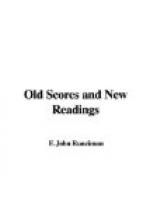subject and treatment merge inseparably one in the
other, substance and form are one; for the idea is
all in all, and the complete idea cannot be perceived
apart from the dress which makes it visible.
Besides, in the Wagnerian music-drama, it is intended
that beauty of idea and of arrangement of ideas shall
be as of great importance as beauty of ornament.
Wagner certainly intended “Parsifal” to
be such a music-drama; and indeed the idea is only
too clearly visible. The main idea of the “Ring”
is so much obscured by the subsidiary ideas twined
about it that very few people know that the real hero
is Wotan, and the central drama Wotan’s tragedy,
that Siegmund and Sieglinde, Siegfried and Bruennhilde,
and their loves—all the romance and loveliness
that enchant us—are merely accessory.
But in “Parsifal” there is nothing superfluous,
no rich and lovely embroidery on the dress of the
idea to divert us from the idea itself—the
idea is as nearly nude as our limited senses and our
modern respectability permit. And the idea being
what it is, it follows that the play, after the drama
once commences, is not only immoral, but also dispiriting
and boring, and, to my thinking, inconsequential and
pointless. The first act, the exposition, is
from beginning to end magnificent: never were
the lines on which a drama was to develop more gorgeously,
or in more masterly fashion, set forth. Had Wagner
seen that Amfortas was merely a hypochondriac, a stage
Schopenhauer, imagining all manner of wounds and evils
where no evils or wounds existed, had he made Parsifal
a Siegfried, and sent him out into the world to learn
this, and brought him back to break up the monastery,
to set Amfortas and the knights to some useful labour,
and to tell them that the sacred spear, like Wotan’s
spear, had power only to hurt those who feared it,
then we might have had an adequate working-out of so
noble a beginning. Instead of this, Kundry kisses
Parsifal, Parsifal squeals, and we see him in a moment
to be only an Amfortas who has had the luck not to
stumble; and he, the poor fool who is filled with so
vast a pity because he sees (what are called) good
and evil in entirely wrong proportion—as,
in fact, a hypochondriac sees them—he, Parsifal,
this thin-blooded inheritor of rickets and an exhausted
physical frame, is called the Redeemer, and becomes
head of the Brotherhood of the Grail. Beside
this inconsequence, all other inconsequences seem as
nothing. One might ask, for instance, how, seeing
that no man can save his brother’s soul, Parsifal
saves the soul of Amfortas? This is a fallacy
that held Wagner all his life. We find it in “The
Flying Dutchman”; it is avoided in “Tannhaeuser”—for,
thank the gods, Tannhaeuser is not saved by
that uninteresting young person Elizabeth; it plays
a large part in the “Ring”; it is the culmination
of the drama of “Parsifal.” Had Wagner
thought more of Goethe and less of the Frankfort creature
who formulated his hypo-chondriacal nightmares, and




